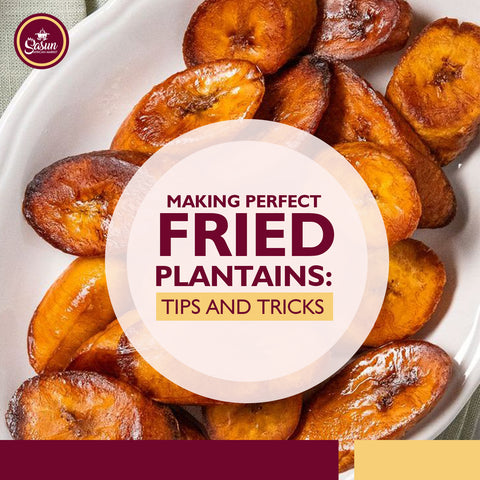Fried plantains are a beloved snack and side dish across many cultures, especially in West Africa, the Caribbean, and Latin America. When done right, fried plantains have crispy edges and a sweet, caramelized center. You can serve them as a snack, side dish, or dessert. No matter the method you choose, the art of frying plantains is easier than you think. Here's your best guide to making perfect fried plantains every time.

Selecting the Right Plantains
The key to perfect fried plantains lies in choosing the right level of ripeness. Here’s what to look for:
- For Sweet Fried Plantains: Use ripe plantains that are yellow with black spots. The riper the plantain, the sweeter and softer it will be.
- For Savory Fried Plantains: Use green or slightly yellow plantains. These are firmer and less sweet, making them ideal for savory dishes.
Also, when selecting plantains, they should be firm to the touch but not rock hard. Avoid plantains that are overly soft or mushy, as they can become too oily when fried.
Preparing Plantains for Frying
Peeling plantains can be tricky if you’re unfamiliar with the process. Here’s a simple method:
- Cut Off the Ends: Use a sharp knife to cut off both ends of the plantain.
- Score the Skin: Make a shallow cut along the length of the plantain. Be careful not to cut too deep.
- Peel Back the Skin: Use your fingers to gently peel back the skin along the cut. The peel should come off easily.

Slicing Plantains
The way you slice plantains can affect their texture and flavor:
- For Crispy Edges: Slice the plantains diagonally into 1/4 to 1/2-inch thick pieces. Diagonal slices increase the surface area for crispiness.
- For Caramelized Centers: Slice the plantains into rounds. This method provides a thicker center that caramelizes beautifully.
Frying Plantains
Choosing the Right Oil: Use an oil with a high smoke point, such as vegetable oil, peanut oil, or canola oil. These oils can handle the high temperatures needed for frying without burning.
Heating the Oil
- Temperature Check: Heat the oil in a large skillet or frying pan over medium-high heat. The oil should be about 350°F (175°C). To test, drop a small piece of plantain into the oil; it should sizzle immediately.
- Oil Depth: The oil should be deep enough to submerge the plantain slices halfway. Too little oil can result in uneven cooking.

Frying Process
- Fry in Batches: Fry the plantain slices in batches to avoid overcrowding the pan. Overcrowding lowers the oil temperature and results in soggy plantains.
- Flip Carefully: Fry each slice for about 2-3 minutes per side, or until golden brown. Use a slotted spoon or tongs to flip the slices carefully.
- Drain Excess Oil: Once fried, remove the plantains from the oil and place them on a plate lined with paper towels to drain excess oil.
Seasoning Fried Plantain
Sweet Fried Plantains: For a sweet treat, sprinkle the fried plantains with a bit of sugar or cinnamon while they are still warm. This adds an extra layer of flavor and enhances the caramelization.
Savory Fried Plantains: If you prefer savory fried plantains, season them with a pinch of salt immediately after frying. You can also add a dash of garlic powder or chili powder for a spicy kick.

Serving Suggestions
Fried plantains are incredibly versatile and can be paired with various dishes:
- As a Side Dish: Serve with rice and beans, grilled meats, or stews.
- As a Snack: Enjoy them on their own or with a dipping sauce like aioli, ketchup, or spicy mayo.
- As a Dessert: Drizzle with honey or chocolate sauce and serve with a scoop of vanilla ice cream.
Tips for Perfect Fried Plantains
- Monitor Oil Temperature: Keep an eye on the oil temperature and adjust the heat as necessary to maintain a consistent frying temperature.
- Avoid Overcrowding: Fry in batches to ensure each slice cooks evenly and crisps up nicely.
- Use Ripe Plantains: For the best flavor, use ripe plantains with plenty of black spots.
- Drain Properly: Let the fried plantains drain on paper towels to remove excess oil and keep them crispy.
Common Mistakes to Avoid
- Using Unripe Plantains for Sweet Versions: Unripe plantains will not caramelize properly and will be too starchy for sweet preparations.
- Overcrowding the Pan: Overcrowding leads to steaming rather than frying, resulting in soggy plantains.
- Incorrect Oil Temperature: If the oil is too hot, the plantains will burn before cooking through. If too cool, they will absorb more oil and become soggy.

Conclusion
Perfect fried plantains are a delicious addition to any meal. By following these tips and tricks, you can achieve crispy, caramelized plantains every time. If you prefer them sweet or savory, fried plantains are sure to delight your taste buds and impress your family and friends.
FAQs
Can I use a deep fryer to fry plantains?
Yes, a deep fryer can be used to fry plantains. Ensure the temperature is set to 350°F (175°C) for best results.
What can I do with leftover fried plantains?
Leftover fried plantains can be reheated in the oven or air fryer to restore their crispiness. They can also be used in sandwiches or as a topping for salads.
Are fried plantains healthy?
Fried plantains can be enjoyed as part of a balanced diet. To make them healthier, use a minimal amount of oil and pair them with nutritious sides.
Can I bake or air fry plantains instead of frying them?
Yes, plantains can be baked or air fried for a healthier alternative. Brush the slices with a little oil and bake at 400°F (200°C) or air fry at the same temperature until golden and crispy.
What is the difference between plantains and bananas?
Plantains are starchier and less sweet than bananas. They are typically cooked before eating, while bananas are usually eaten raw.
How do I know when plantains are ripe?
Ripe plantains have a yellow skin with black spots. The riper they are, the sweeter they become. For savory dishes, use green or slightly yellow plantains.







Comments (4)
Am here to let the whole world know that I was diagnose of herpes 3 years ago where all hope was lost and I had nothing to do about it,I just accepted the faith that one day I will cure of this disease and I just pray everyday for a helper and one day my sister introduce me to a herbal doctor man called Dr ahonsie that she saw him on internet well I contact him on his email,I was not fully convinced until he sent me the herbal medicine which he ask me to take for two weeks I took it with faith and i went for a retest in different hospitals and today am cured of this disease and am also using this medium to let all those having STD,like herpes and the rest not to give up,their is a man who can cure you,his name is Dr ahonsie . contact the great herbalist via his Email: drahonsie00@gmail.com / WhatsApp: +2348039482367. https://drahonsie002.wixsite.com/dr-ahonsie
I would never have believed that cold sore herpes virus can be cured with ancient herbal medicine because I just tested negative for the second time since I finished drinking the medicine a herbal doctor sent to me, all the sores and blisters were gone immediately I started drinking the herbal meds, so I want you all to know that herpes virus can be cured with the right use of ancient herbal medicine so visit this herbalist called doctor excel on his Email: drahonsie00@gmail.com / WhatsApp: +2348039482367. https://drahonsie002.wixsite.com/dr-ahonsie https://www.facebook.com/drstellaherbalhome?mibextid=ZbWKwLThanks
Hello everyone, i have a very important information about herpes virus, i was a victim of hsv1&2 until i met doctor Ahonsie, it still feels like a dream to me. it has been two years now, i have not experience any breakout of herpes. I new about him through a post made on social media, a lady shares her experience and then i decided to contact him and ever since i contacted i was encourage and with no doubt i was cured from herpes simplex in just two weeks. He also treat other illnesses like HPV, HIV, CANCER, THYRIOD, PENIS ENLARGEMENT, and more contact him via Email: drahonsie00@gmail.com / WhatsApp: +2348039482367. https://drahonsie002.wixsite.com/dr-ahonsie https://www.facebook.com/drstellaherbalhome?mibextid=ZbWKwLThanks
My purpose out here today is to share this article to the world about how Doctor Odunga helped me in getting back my EX-boyfriend who broke up with me 4 months ago. I tried all I could to make him see reasons with me so that we can continue our relationship but he denied me. Thank God for giving me the thought of going into the internet for help, I searched properly and I saw different reviews of Doctor Odunga and I insisted on giving it a try by contacting him via what’s app on (+2348167159012). He gave me reason to live again and he prepared a spell and told me that my Ex-boyfriend will come back to me within 11 hours. Can you believe it, my EX-boyfriend came back to me, proposed to me and our wedding will be held soon. Contact him now!!! if you need any help. Email: odungaspelltemple@gmail.com and he does a lot of spells. Once again i want to say am very grateful for your help